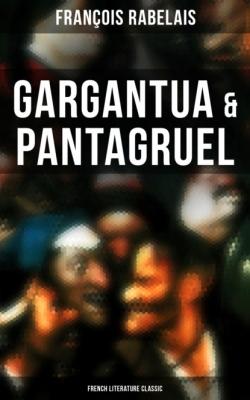Gargantua & Pantagruel (French Literature Classic). Francois Rabelais
Читать онлайн.| Название | Gargantua & Pantagruel (French Literature Classic) |
|---|---|
| Автор произведения | Francois Rabelais |
| Жанр | Языкознание |
| Серия | |
| Издательство | Языкознание |
| Год выпуска | 0 |
| isbn | 4064066397043 |
Chapter 5.XXI.—How the Queen passed her time after dinner.
Chapter 5.XXIII.—How the Queen was served at dinner, and of her way of eating.
Chapter 5.XXV.—How the thirty-two persons at the ball fought.
Chapter 5.XXVI.—How we came to the island of Odes, where the ways go up and down.
Chapter 5.XXVII.—How we came to the island of Sandals; and of the order of Semiquaver Friars.
Chapter 5.XXIX.—How Epistemon disliked the institution of Lent.
Chapter 5.XXX.—How we came to the land of Satin.
Chapter 5.XXXI.—How in the land of Satin we saw Hearsay, who kept a school of vouching.
Chapter 5.XXXII.—How we came in sight of Lantern-land.
Chapter 5.XXXIII.—How we landed at the port of the Lychnobii, and came to Lantern-land.
Chapter 5.XXXIV.—How we arrived at the Oracle of the Bottle.
Chapter 5.XXXVI.—How we went down the tetradic steps, and of Panurge’s fear.
Chapter 5.XXXVII.—How the temple gates in a wonderful manner opened of themselves.
Chapter 5.XXXVIII.—Of the Temple’s admirable pavement.
Chapter 5.XXXIX.—How we saw Bacchus’s army drawn up in battalia in mosaic work.
Chapter 5.XLI.—How the temple was illuminated with a wonderful lamp.
Chapter 5.XLIII.—How the Priestess Bacbuc equipped Panurge in order to have the word of the Bottle.
Chapter 5.XLIV.—How Bacbuc, the high-priestess, brought Panurge before the Holy Bottle.
Chapter 5.XLV.—How Bacbuc explained the word of the Goddess-Bottle.
Chapter 5.XLVI.—How Panurge and the rest rhymed with poetic fury.
Chapter 5.XLVII.—How we took our leave of Bacbuc, and left the Oracle of the Holy Bottle.
Introduction.
Had Rabelais never written his strange and marvellous romance, no one would ever have imagined the possibility of its production. It stands outside other things—a mixture of mad mirth and gravity, of folly and reason, of childishness and grandeur, of the commonplace and the out-of-the-way, of popular verve and polished humanism, of mother-wit and learning, of baseness and nobility, of personalities and broad generalization, of the comic and the serious, of the impossible and the familiar. Throughout the whole there is such a force of life and thought, such a power of good sense, a kind of assurance so authoritative, that he takes rank with the greatest; and his peers are not many. You may like him or not, may attack him or sing his praises, but you cannot ignore him. He is of those that die hard. Be as fastidious as you will; make up your mind to recognize only those who are, without any manner of doubt, beyond and above all others; however few the names you keep, Rabelais’ will always remain.
We may know his work, may know it well, and admire it more every time we read it. After being amused by it, after having enjoyed it, we may return again to study it and to enter more fully into its meaning. Yet there is no possibility of knowing his own life in the same fashion. In spite of all the efforts, often successful, that have been made to throw light on it, to bring forward a fresh document, or some obscure mention in a forgotten book, to add some little fact, to fix a date more precisely, it remains nevertheless full of uncertainty and of gaps. Besides, it has been burdened and sullied by all kinds of wearisome stories and foolish anecdotes, so that really there is more to weed out than to add.
This injustice, at first wilful, had its rise in the sixteenth century, in the furious attacks of a monk of Fontevrault, Gabriel de Puy-Herbault, who seems to have drawn his conclusions concerning the author from the book, and, more especially, in the regrettable satirical epitaph of Ronsard, piqued, it is said, that the Guises had given him only a little pavillon in the Forest of Meudon, whereas the presbytery was close to the chateau. From that time legend has fastened on Rabelais, has completely travestied him, till, bit by bit, it has made of him a buffoon, a veritable clown, a vagrant, a glutton, and a drunkard.
The likeness of his person has undergone a similar metamorphosis. He has been credited with a full moon of a face, the rubicund nose of an incorrigible toper, and thick coarse lips always apart because always laughing. The picture would have surprised his friends no less than himself. There have been portraits painted of Rabelais; I have seen many such. They are all of the seventeenth century, and the greater number are conceived in this jovial and popular style.
As a matter of fact there is only one portrait of him that counts, that has more than the merest chance of being authentic, the one in the Chronologie collee or coupee. Under this double name is
